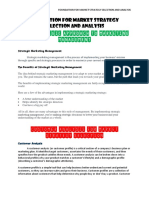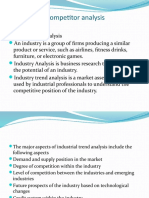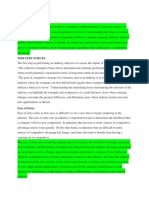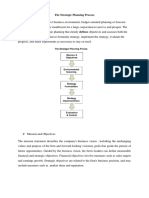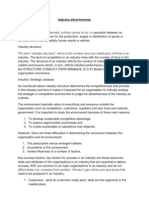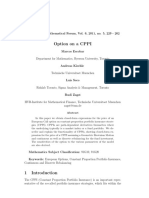Industry Analysis & Company Profiling
Industry Analysis & Company Profiling
Uploaded by
Subhesh MohantyCopyright:
Available Formats
Industry Analysis & Company Profiling
Industry Analysis & Company Profiling
Uploaded by
Subhesh MohantyOriginal Title
Copyright
Available Formats
Share this document
Did you find this document useful?
Is this content inappropriate?
Copyright:
Available Formats
Industry Analysis & Company Profiling
Industry Analysis & Company Profiling
Uploaded by
Subhesh MohantyCopyright:
Available Formats
Q. What is Michael Porter’s five competitive forces model?
Ans: Michael Porter's five competitive forces model, also known as Porter's Five Forces analysis, is a strategic
framework developed by Michael E. Porter, a renowned economist and professor at Harvard Business School. The
model is widely used in business management, including in MBA programs, to analyze the competitive environment
of an industry and identify key factors that can affect a company's profitability and competitiveness. The model
consists of five forces that shape industry competition and influence a company's strategic decisions. Here are the
five forces of Porter's model:
1. Threat of New Entrants: This force examines the barriers to entry for new companies in the industry.
Higher barriers make it difficult for new players to enter the market, limiting competition and potentially
providing advantages to existing firms. Barriers can include factors like economies of scale, brand loyalty,
capital requirements, access to distribution channels, and government regulations. If the threat of new
entrants is low, existing firms can enjoy a more stable market position.
2. Bargaining Power of Suppliers: This force assesses the influence that suppliers have over the industry and
its firms. Suppliers' power can increase when there are limited alternatives for inputs or unique resources,
or when switching costs are high. In such cases, suppliers can dictate terms, prices, and quality, which may
negatively impact a company's profitability. Conversely, when suppliers have less power, firms can
negotiate better deals and reduce costs.
3. Bargaining Power of Buyers: This force considers the influence that customers or buyers have over the
industry and its firms. Buyers' power increases when they have many choices, low switching costs, and
access to information about products and prices. When buyers have significant power, they can demand
lower prices or higher product quality, which can squeeze profit margins for firms.
4. Threat of Substitutes: This force evaluates the availability of alternative products or services that can fulfill
similar needs to those offered by the industry's products. The presence of close substitutes can limit the
price-setting ability of firms and reduce their market share. Industries with a higher threat of substitutes
face greater competition and need to differentiate their offerings to maintain a competitive advantage.
5. Intensity of Competitive Rivalry: This force examines the level of competition among existing firms in the
industry. High competitive rivalry results from factors like a large number of competitors, slow industry
growth, and low differentiation among products or services. In such environments, firms often engage in
price wars and aggressive marketing to gain a competitive edge. On the other hand, industries with low
competitive rivalry tend to have more stable market conditions and higher profit potential.
By analyzing these five forces, businesses can gain valuable insights into their industry's competitive dynamics and
develop strategic plans to strengthen their market position, enhance competitiveness, and respond effectively to
market challenges. MBA programs often emphasize the importance of Porter's Five Forces model as a tool for
strategic analysis and decision-making in various industries and business scenarios.
Q. What is competitive analysis and how do you obtain it?
ANS: Competitive analysis is a critical strategic tool used by businesses to assess their competitive environment and
understand how they compare to their competitors in the market. It involves evaluating the strengths and weaknesses of
competing companies, identifying their strategies, and determining opportunities and threats they pose to one's own business.
Competitive analysis helps businesses make informed decisions and formulate effective strategies to gain a competitive
advantage and achieve their objectives. For MBA students, understanding competitive analysis is essential as it enables them to
develop strategic thinking and decision-making skills.
The process of obtaining competitive analysis involves several steps, and here are the key steps
that an MBA student should consider:
The process of obtaining competitive analysis involves several steps, and here are the key steps that an
MBA student should consider:
Define the Industry and Competitors: Identify the industry in which your business operates and list the
major competitors. The industry may be broad or narrow, depending on the scope of your business. Define
the market segments, customer groups, and geographic regions that are relevant to your business.
Gather Data on Competitors: Collect comprehensive data on each competitor in your industry. This can
include information from publicly available sources, such as financial statements, annual reports, websites,
press releases, and news articles. Analyze their products, services, pricing strategies, market share, target
customers, distribution channels, and marketing efforts.
SWOT Analysis: Conduct a SWOT (Strengths, Weaknesses, Opportunities, and Threats) analysis for each
competitor. Identify their core competencies, unique selling propositions, and areas where they excel or lag
behind. Evaluate their market positioning and potential areas for growth or improvement.
Analyze Market Trends: Understand the prevailing market trends, including technological advancements,
regulatory changes, consumer preferences, and macroeconomic factors. Analyze how these trends impact
your competitors and their strategies.
Assess Competitive Advantage: Compare your business's strengths and weaknesses against your
competitors. Identify areas where your business has a competitive advantage and areas where you need to
improve to stay competitive. This analysis can help you focus on your unique selling points and
differentiation strategies.
Identify Opportunities and Threats: Based on the competitive analysis, identify potential opportunities for
your business to expand or gain a stronger market position. Simultaneously, identify threats that your
competitors pose to your business, such as pricing wars or new product launches.
Competitive Positioning: Develop a clear understanding of your competitive positioning relative to other
players in the industry. Determine whether your business is a market leader, follower, or niche player.
Define your competitive strategy and positioning to address market opportunities effectively.
Monitor and Update: Competitive analysis is an ongoing process. Continuously monitor changes in the
competitive landscape and update your analysis regularly. Stay alert to new competitors entering the market
or shifts in customer preferences.
By obtaining and conducting a comprehensive competitive analysis, MBA students and businesses can gain valuable
insights into their market dynamics, develop effective strategies, and make informed decisions that lead to
sustainable competitive advantages and long-term success.
Q. What are the methods to analyses an industry?
Ans: Analyzing an industry is a crucial step in strategic management and decision-making for businesses,
and it helps MBA students develop a comprehensive understanding of market dynamics and competitive
forces. There are several methods to analyze an industry, each providing unique insights into the
industry's structure, competitive landscape, and potential opportunities and threats. Here are the key
methods for industry analysis:
1. Porter's Five Forces Analysis: As discussed earlier, Porter's Five Forces analysis is a widely used method to
assess industry competitiveness. It examines five key forces that shape industry competition: threat of new
entrants, bargaining power of suppliers, bargaining power of buyers, threat of substitutes, and intensity of
competitive rivalry. By analyzing these forces, businesses can understand the attractiveness of the industry
and the level of competition they face.
2. SWOT Analysis: SWOT (Strengths, Weaknesses, Opportunities, Threats) analysis is a versatile tool for
evaluating an industry's internal and external factors. Businesses identify their own strengths and
weaknesses and assess the opportunities and threats present in the industry. SWOT analysis helps
companies understand their competitive position and develop strategies to capitalize on strengths and
opportunities while addressing weaknesses and threats.
3. PESTEL Analysis: PESTEL analysis considers the external macro-environmental factors that influence an
industry: Political, Economic, Social, Technological, Environmental, and Legal factors. This method helps
businesses understand the impact of broader environmental factors on their industry and identify
potential risks and opportunities.
4. Value Chain Analysis: Value chain analysis breaks down the various activities involved in producing a
product or service within an industry. It helps businesses identify cost drivers and potential areas for value
addition. By understanding the value chain of an industry, companies can determine how they can create
a competitive advantage through efficient operations and differentiation.
5. Industry Life Cycle Analysis: Industry life cycle analysis categorizes industries into different stages:
Introduction, Growth, Maturity, and Decline. Understanding the industry's life cycle helps businesses tailor
their strategies based on the current stage of the industry. Different strategies are appropriate in each
stage, such as innovation in the introduction stage or cost-cutting in the maturity stage.
6. Market Segmentation Analysis: Market segmentation analysis involves dividing the market into distinct
customer segments based on specific characteristics or preferences. This method helps businesses identify
target markets and tailor their products, marketing, and distribution strategies to meet the needs of
different customer segments.
7. Competitive Benchmarking: Competitive benchmarking involves comparing a company's performance and
practices with those of its competitors. This analysis provides insights into the relative strengths and
weaknesses of the business compared to its rivals. Benchmarking helps companies identify areas for
improvement and best practices to adopt.
8. Financial Ratio Analysis: Financial ratio analysis examines the financial performance of companies within
the industry. It assesses liquidity, profitability, efficiency, and other financial metrics. This analysis helps
businesses understand their financial health and compare it with industry averages.
By using a combination of these methods, MBA students and businesses can gain a comprehensive
understanding of the industry's dynamics, competitive forces, and growth opportunities. This information
is essential for formulating effective strategies, making informed decisions, and achieving sustainable
success in the industry.
You might also like
- Income Statement Practice ProblemsDocument6 pagesIncome Statement Practice Problemsmike83% (6)
- Process Costing Template - FIFO and WADocument2 pagesProcess Costing Template - FIFO and WADan Cromack100% (5)
- Porter's Five Forces: Understand competitive forces and stay ahead of the competitionFrom EverandPorter's Five Forces: Understand competitive forces and stay ahead of the competitionRating: 4 out of 5 stars4/5 (10)
- Bessemer Benchmarks: Plot Your Way To The Next MilestoneDocument10 pagesBessemer Benchmarks: Plot Your Way To The Next MilestoneNathan YehNo ratings yet
- Competitor AnalysisDocument9 pagesCompetitor Analysisvarsha raichalNo ratings yet
- Maam Gelen ReortDocument23 pagesMaam Gelen Reorta cup of coffeeNo ratings yet
- Individual Strategic ManagementDocument3 pagesIndividual Strategic Management8124ngocmaiNo ratings yet
- Why Do We Have To Analyze, Industry and Competition?Document6 pagesWhy Do We Have To Analyze, Industry and Competition?Axle InsigneNo ratings yet
- Market Analysis ToolsDocument15 pagesMarket Analysis ToolschepkemeiNo ratings yet
- 2.3 Competitive Environment and Industry AnalysisDocument2 pages2.3 Competitive Environment and Industry Analysisotienogodwin130No ratings yet
- Module 6 - Foundation For Market Strategy Selection and AnalysisDocument13 pagesModule 6 - Foundation For Market Strategy Selection and Analysisalma agnasNo ratings yet
- Strategic ManagmentDocument4 pagesStrategic Managmentankitmunda69No ratings yet
- Entreprenership BBA Unit 5Document35 pagesEntreprenership BBA Unit 5Satish Kumar RanjanNo ratings yet
- Marketing Analysis Situation AnalysisDocument21 pagesMarketing Analysis Situation AnalysisBBHM-F19-253 AMEER ALINo ratings yet
- Competitors' AnalysisDocument39 pagesCompetitors' Analysisharisshaikh7070No ratings yet
- chapter 3Document13 pageschapter 3endegenaalemayehu4545No ratings yet
- Internet Research Chapter 9Document5 pagesInternet Research Chapter 9Kil ZoldyckNo ratings yet
- Unit FiveDocument40 pagesUnit FiveManish OjhaNo ratings yet
- Chapter 3 Industry and Competitive AnalysisDocument44 pagesChapter 3 Industry and Competitive AnalysisNesley Vie Lamo100% (1)
- Portersfiveforces PDFDocument7 pagesPortersfiveforces PDFBrian DsouzaNo ratings yet
- Industry Analysis: Positioning The FirmDocument5 pagesIndustry Analysis: Positioning The FirmDonrost Ducusin Dulatre100% (1)
- Reviewer Compre 1Document30 pagesReviewer Compre 1Dexter AlcantaraNo ratings yet
- Marketing Management AssignmentDocument32 pagesMarketing Management Assignmentwerksew tsegayeNo ratings yet
- Explain Detail Tools For IndustryDocument2 pagesExplain Detail Tools For IndustryChoNo ratings yet
- Topics of MISDocument7 pagesTopics of MISCarolina SmithNo ratings yet
- Industry AnalysisDocument29 pagesIndustry AnalysisMarie Joy CentinoNo ratings yet
- The Five Competitive Forces That Shape StrategyDocument2 pagesThe Five Competitive Forces That Shape StrategyDenzel Luna QuiambaoNo ratings yet
- Topic: Porter'S Five Forces Model: Decision Making & SteeringDocument7 pagesTopic: Porter'S Five Forces Model: Decision Making & SteeringNguyệt Minh LêNo ratings yet
- Chapter Three straDocument16 pagesChapter Three strasisajybazezewNo ratings yet
- Strategic ManagementDocument14 pagesStrategic Managementalamzunaid448No ratings yet
- The Strategic Planning ProcessDocument10 pagesThe Strategic Planning ProcessSyed Faiz QuadriNo ratings yet
- Case StudiesDocument14 pagesCase StudiesdiljitNo ratings yet
- AssignmentDocument3 pagesAssignmentallenapellido05No ratings yet
- Porters 5 Forces AnalysisDocument6 pagesPorters 5 Forces AnalysisRobi MatiNo ratings yet
- Progress Test 1 (Da Chinh Sua)Document7 pagesProgress Test 1 (Da Chinh Sua)Võ Lương Phương NamNo ratings yet
- Marketing Strategy: Introduction and Overview: Portfolio AnalysisDocument8 pagesMarketing Strategy: Introduction and Overview: Portfolio AnalysisarvinddorwatNo ratings yet
- New SmallDocument3 pagesNew SmallGEORGE SARPONGNo ratings yet
- Intra Industry AnalysisDocument9 pagesIntra Industry AnalysisManzzieNo ratings yet
- Strategic MarketingDocument52 pagesStrategic MarketingAnkit Sharma 028No ratings yet
- Unit 2 - Business PolicyDocument30 pagesUnit 2 - Business PolicysodusfurikNo ratings yet
- ENTR 11 LESSON 4.2.v2Document40 pagesENTR 11 LESSON 4.2.v2Mavie Jade LawagNo ratings yet
- Entre CH 5Document30 pagesEntre CH 5Sena KenaNo ratings yet
- Competitor AnalysisDocument12 pagesCompetitor AnalysiskiranaishaNo ratings yet
- External AnalysisDocument8 pagesExternal AnalysisYasmine MancyNo ratings yet
- WHAT IS MARKET ANALYSISDocument35 pagesWHAT IS MARKET ANALYSISmuhwezi057No ratings yet
- Week 4 Mkc2210 Competitor AnalysisDocument11 pagesWeek 4 Mkc2210 Competitor Analysiscreative7989No ratings yet
- Use Appropriate Analysis Framework and Methodology in (ABM - BES12-Ia-c-2)Document8 pagesUse Appropriate Analysis Framework and Methodology in (ABM - BES12-Ia-c-2)Aimee Lasaca100% (1)
- Business Plan ReportDocument11 pagesBusiness Plan ReportGenelyn Cabudsan MancolNo ratings yet
- Frameworks ExplainedDocument6 pagesFrameworks ExplainedAvni ChawlaNo ratings yet
- Chapter 2-Part 2Document17 pagesChapter 2-Part 2linhlinh0055No ratings yet
- Hope University College: Master of Business Administration (MBA) ProgramDocument6 pagesHope University College: Master of Business Administration (MBA) ProgramBemnetNo ratings yet
- Unit 1 - Porter Five Forces AnalysisDocument11 pagesUnit 1 - Porter Five Forces AnalysisRoshan SheikhNo ratings yet
- Organization and Its EnvironmentDocument20 pagesOrganization and Its EnvironmentPrasanga PriyankaranNo ratings yet
- Industry AnalysisDocument14 pagesIndustry AnalysisPurna Chandra MohantyNo ratings yet
- Strategic Mngt.Document49 pagesStrategic Mngt.Precious AlvaroNo ratings yet
- What Is The Scope of Situational Analysis in Relation To Business AnalysisDocument3 pagesWhat Is The Scope of Situational Analysis in Relation To Business AnalysisalvinNo ratings yet
- Chapter Three: Analytical Methods and Techniques of Innovation ManagementDocument11 pagesChapter Three: Analytical Methods and Techniques of Innovation ManagementPoii GNo ratings yet
- 5 ForceDocument5 pages5 ForceMichael YongNo ratings yet
- Industry AttractivenessDocument9 pagesIndustry AttractivenessSakshi DangiNo ratings yet
- Entrep Q3 M5Document10 pagesEntrep Q3 M5Gilbert JohnNo ratings yet
- MGT 401mid Term VivaDocument4 pagesMGT 401mid Term Vivaகப்பல்ஹசன்நபிNo ratings yet
- Competitive AnalysisDocument67 pagesCompetitive AnalysisHariKishanNo ratings yet
- Entrepreneurship Ch 5Document25 pagesEntrepreneurship Ch 5gezukotuNo ratings yet
- Class 11 24-25 Holiday HomeworkDocument7 pagesClass 11 24-25 Holiday Homeworkyashikagupta10a.doonNo ratings yet
- 2403 6406 1 PBDocument20 pages2403 6406 1 PBAndi KomaraNo ratings yet
- Ey Worldwide Transfer Pricing Reference Guide 2022 23 v1Document795 pagesEy Worldwide Transfer Pricing Reference Guide 2022 23 v1Nicole SpiteriNo ratings yet
- Global Report - Most Valuable BrandsDocument15 pagesGlobal Report - Most Valuable BrandspsggNo ratings yet
- Term Paper 1Document15 pagesTerm Paper 1Jerico MagnoNo ratings yet
- October 30, 2021: Attention: Ms. Karen Fae Pineda - Madrid JS Bookkeeping ServicesDocument2 pagesOctober 30, 2021: Attention: Ms. Karen Fae Pineda - Madrid JS Bookkeeping ServicesJeremy OrtegaNo ratings yet
- Current Affairs Pocket PDF - June 2024 by AffairsCloud 1Document103 pagesCurrent Affairs Pocket PDF - June 2024 by AffairsCloud 1lspatawat9No ratings yet
- Final Exam/2: Multiple ChoiceDocument4 pagesFinal Exam/2: Multiple ChoiceJing SongNo ratings yet
- Option On A CPPIDocument34 pagesOption On A CPPIdeepNo ratings yet
- Indian Economy On The Eve of IndependenceDocument14 pagesIndian Economy On The Eve of Independenceprasiddhi123No ratings yet
- Assignment - Subsequent To AcquisitionDocument1 pageAssignment - Subsequent To AcquisitionWilliam LanzuelaNo ratings yet
- ProfileDocument13 pagesProfilegreenrootfinancialservicesNo ratings yet
- ALFM Peso Bond Fund Inc. - 202205 1Document2 pagesALFM Peso Bond Fund Inc. - 202205 1C KNo ratings yet
- Scope and LimitationDocument5 pagesScope and LimitationVivek Kumar50% (4)
- HEPBURN - Solution DevDocument7 pagesHEPBURN - Solution DevAbishek GuptaNo ratings yet
- How To Budget - Ankur WarikooDocument8 pagesHow To Budget - Ankur Warikoohricha.vimalNo ratings yet
- Lecture Notes on Chapter 8Document11 pagesLecture Notes on Chapter 8zumoritotakufushite010123No ratings yet
- CotizacionDocument2 pagesCotizacionAriel Andres Montes VidalNo ratings yet
- Press Release of Birla Estates Private Limited A Wholly Owned Subsidiary of Century Textiles and Industries Limited 15 July 2024Document2 pagesPress Release of Birla Estates Private Limited A Wholly Owned Subsidiary of Century Textiles and Industries Limited 15 July 2024maxarea001No ratings yet
- Report On Customer RetentionDocument46 pagesReport On Customer Retentiontriptisharma72808No ratings yet
- Notes Fnce 313 Money and Banking Notes January 2020Document105 pagesNotes Fnce 313 Money and Banking Notes January 2020Kanana kimathiNo ratings yet
- A Pre-Feasibility Study For The Establishment of A Tourist Village and Chalets in AjlounDocument38 pagesA Pre-Feasibility Study For The Establishment of A Tourist Village and Chalets in AjlounSumant AggNo ratings yet
- Overall Report For Terminal - PresentedDocument76 pagesOverall Report For Terminal - PresentedMahbuburRahmanJesanNo ratings yet
- IJHMAUnemploymentand House PricesDocument18 pagesIJHMAUnemploymentand House PricesxinyuNo ratings yet
- Administrative Assistant Job AdDocument2 pagesAdministrative Assistant Job Adsaw thomasNo ratings yet
- Current Affairs Q&A PDF November 16 2024 by Affairscloud 1 1Document20 pagesCurrent Affairs Q&A PDF November 16 2024 by Affairscloud 1 1medafot405No ratings yet
- Chennai Trade Centre Exhibition ListDocument10 pagesChennai Trade Centre Exhibition ListLavkesh SinghNo ratings yet










